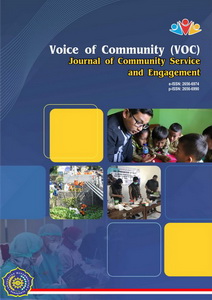Elderly Class (Yoga, Acupressure and Progressive Muscle Reflexology) to Improve Elderly Health in Tambakmulyo Village, Puring, Kebumen
DOI:
https://doi.org/10.23917/voc.v4i3.10248Keywords:
Lansia, Yoga, ROP, AkupresureAbstract
Elderly is someone who has entered the age of 60 years and above. The elderly are an age group in humans who have entered the final stage of their life phase. The increase in the number of elderly people has an impact, among others, the emergence of degenerative disease problems that often accompany chronic and multipathological elderly people such as hypertension, heart disease, diabetes mellitus, uterine / prostate cancer, osteoporosis and others, where the handling takes a long time and costs a lot. Elderly classes for elderly health are expected to foster the ability of the elderly themselves to overcome health problems with the support and guidance of professionals, towards the realization of a healthy elderly life. The design of activities to achieve goals is planning (planning), implementation (action), evaluation (evaluation) and follow-up (follow up). In detail the methods and mechanisms. The results of the activity refer to the predetermined target outcomes, namely that the elderly can take part in elderly classes and can increase the elderly's knowledge about Yoga, Acupressure, and Progressive Muscle Reflexology. Yoga, acupressure, and ROP training will increase the knowledge of the elderly, so that it will also affect the accuracy of yoga, acupressure, and ROP training. By getting training, it is hoped that the elderly can understand and be skilled in applying yoga, acupressure, and ROP.
Downloads
References
Permenkes No. 67 Tahun 2015. (n.d.). Database Peraturan | JDIH BPK. https://peraturan.bpk.go.id/Details/116533/permenkes-no-67-tahun-2015
United Nations, Department of Economic and Social Affairs, Population Division. (n.d.). Www.un.org. https://www.un.org/en/development/desa/population/
Mengko, R. (2015). Instrumen Laboratorium Klinik. Bandung: ITB
Kusumastuti, Indriyastuti, H. I., & Na’mah, L. U. (2021). The Effectivities of Yoga Gymnastic to Decrease the Level of Postpartum Blues Incidence. Advances in Health Sciences Research. https://doi.org/10.2991/ahsr.k.210115.086
Setiawan, L. R. S., Mardiyono, & Santjaka, A. (2021). The Effectiveness of Acupressure and Warm Foot Soak Hydrotherapy on Increasing Muscle Strength and Range of Motion among Non-Hemorrhagic Stroke Patients. International Journal of Nursing and Health Services (IJNHS), 4(4), 430–439. https://doi.org/10.35654/ijnhs.v4i4.486
Taufiqurrahman, R. (2022). Pengaruh Terapi Akupresur terhadap Perubahan Tekanan Darah pada Penderita Hipertensi: Literatur Review.
Murniati, M., Sundari, R. I., & Dewi, F. K. (2020). Pelatihan Relaksasi Otot Progresif Pada Kader Posyandu Lansia di Posyandu Lansia RW 05 Desa Kalibagor. Journal of Community Engagement in Health, 3(1), 74–81. https://doi.org/10.30994/jceh.v3i1.39
S. Notoatmodjo, (2011). Promosi kesehatan dan ilmu perilaku, Pusat Informasi Kesehatan Masyarakat: Rineka Cipta.
Notoatmodjo, S. (2013). Promosi kesehatan dan perilaku kesehatan. Pusat Informasi Kesehatan Masyarakat; Rineka Cipta.
Dumurgier, J., & Tzourio, C. (2020). Epidemiology of neurological diseases in older adults. Revue Neurologique, 176(9), 642–648. https://doi.org/10.1016/j.neurol.2020.01.356
Downloads
Submitted
Accepted
Published
How to Cite
Issue
Section
License
Copyright (c) 2025 Kusumastuti Kusumastuti, Siti Muthoharoh, Wulan Rahmadhani

This work is licensed under a Creative Commons Attribution 4.0 International License.








